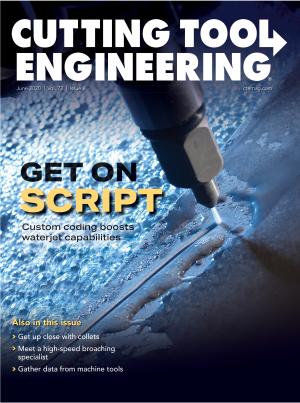Designed for completing a wide range of projects, the Uni-Vee is a single V-block fixture from Seattle-based Dunlap Tool and Die Inc. The fixture has a rectangular main body and is indexable by 180° about a vertical axis and 90° each way about a horizontal axis to provide repeatable vertical and horizontal positioning.
“The V-block can be used to machine the workpiece with an unusual amount of flexibility, and both can be moved around the shop as one unit,” said Mark Dunlap, owner and operator of Dunlap Tool and Die and inventor of the fixture.
The design specifically allows a user to quickly and accurately rotate the fixture 180°. The Uni-Vee holds one workpiece and enables users to work on multiple sides of a part in a single fixturing.
The prototype of the Uni-Vee fixture is shown in use. Image courtesy of Dunlap Tool and Die
With a clamping range from 50.8 mm (2") to 304.8 mm (12"), the standard Uni-Vee is offered with a chain and pawl clamp system that is adjustable from both ends. Once adjusted, a centrally operated mechanism clamps and locks with one motion. A single motion similarly unlocks and unclamps a workpiece and subfixture. A baseplate accessory permits easier access to the common data point feature when indexing.
“In my experience,” Dunlap said, “V-block fixturing has always presented a number of shortcomings. When the unusual combination of a current job requirement and available time/materials allowed the opportunity, I built a fixture that would address a couple of those shortcomings in the hopes of finding occasional shop use for it.”
With no protrusions on its front, back or bottom, the Uni-Vee can be installed directly into a milling vise or laid flat on a table or surface plate. This capability also lets the fixture lie down for the contouring of custom jaws, eliminating the need for a special fixture and potentially increasing the accuracy of shop-built jaws.
“The main benefit is its flexibility,” Dunlap said. “You can do so much with it. Even in the CNC programming environment, you can make it all work as one unit to make it as simple as possible. It also has replaceable, configurable and removable jaws.”
He said the fixture can be attached to an older machine to rough bores, grab them and attach them on a CNC. The Uni-Vee enables older, underutilized machines to be used economically.
“Let’s say I have an 8"-dia. (203 mm) piece of stock and it needs a 4"-dia. (102 mm) hole in it,” Dunlap said. “You don’t want to rough a big bore on a small CNC machine because it’s abusive to the expensive machine.”
The Uni-Vee’s indexing feature and clamping security offer fast setups and sufficient holding power for precise, efficient cuts.
For more information about Dunlap Tool and Die, call 360-202-6271 or visit www.univeefixtures.com.
Related Glossary Terms
- V-block
V-block
Workholding device with V-shaped slot for holding pipe and other round stock during machining or inspection.
- computer numerical control ( CNC)
computer numerical control ( CNC)
Microprocessor-based controller dedicated to a machine tool that permits the creation or modification of parts. Programmed numerical control activates the machine’s servos and spindle drives and controls the various machining operations. See DNC, direct numerical control; NC, numerical control.
- fixture
fixture
Device, often made in-house, that holds a specific workpiece. See jig; modular fixturing.
- flat ( screw flat)
flat ( screw flat)
Flat surface machined into the shank of a cutting tool for enhanced holding of the tool.
- gang cutting ( milling)
gang cutting ( milling)
Machining with several cutters mounted on a single arbor, generally for simultaneous cutting.
- milling
milling
Machining operation in which metal or other material is removed by applying power to a rotating cutter. In vertical milling, the cutting tool is mounted vertically on the spindle. In horizontal milling, the cutting tool is mounted horizontally, either directly on the spindle or on an arbor. Horizontal milling is further broken down into conventional milling, where the cutter rotates opposite the direction of feed, or “up” into the workpiece; and climb milling, where the cutter rotates in the direction of feed, or “down” into the workpiece. Milling operations include plane or surface milling, endmilling, facemilling, angle milling, form milling and profiling.


